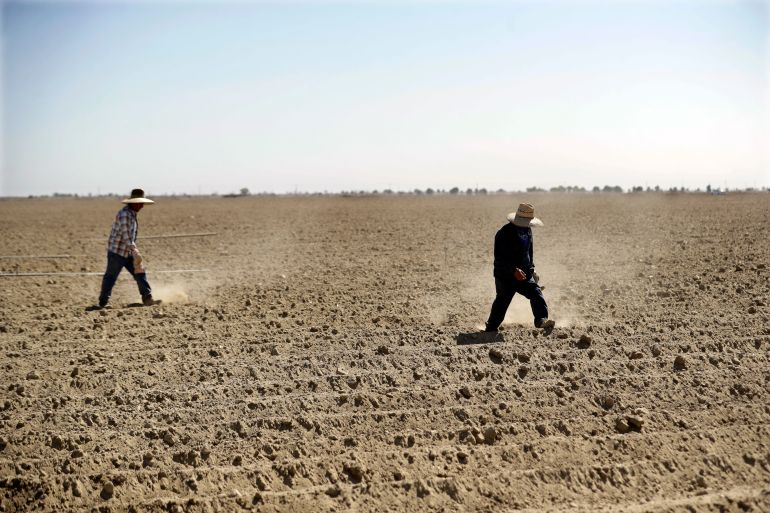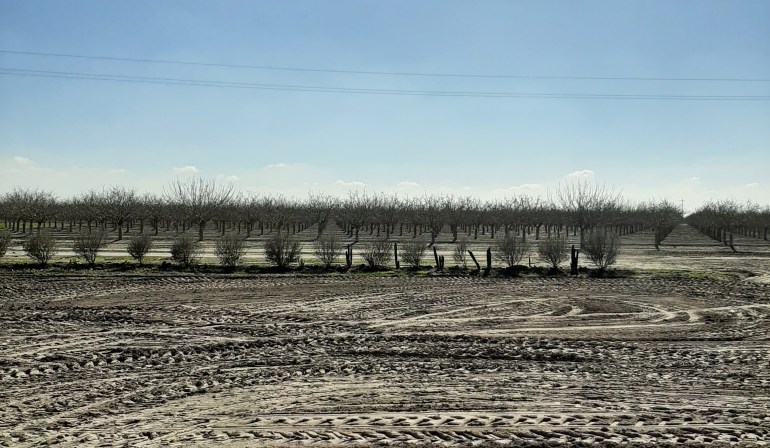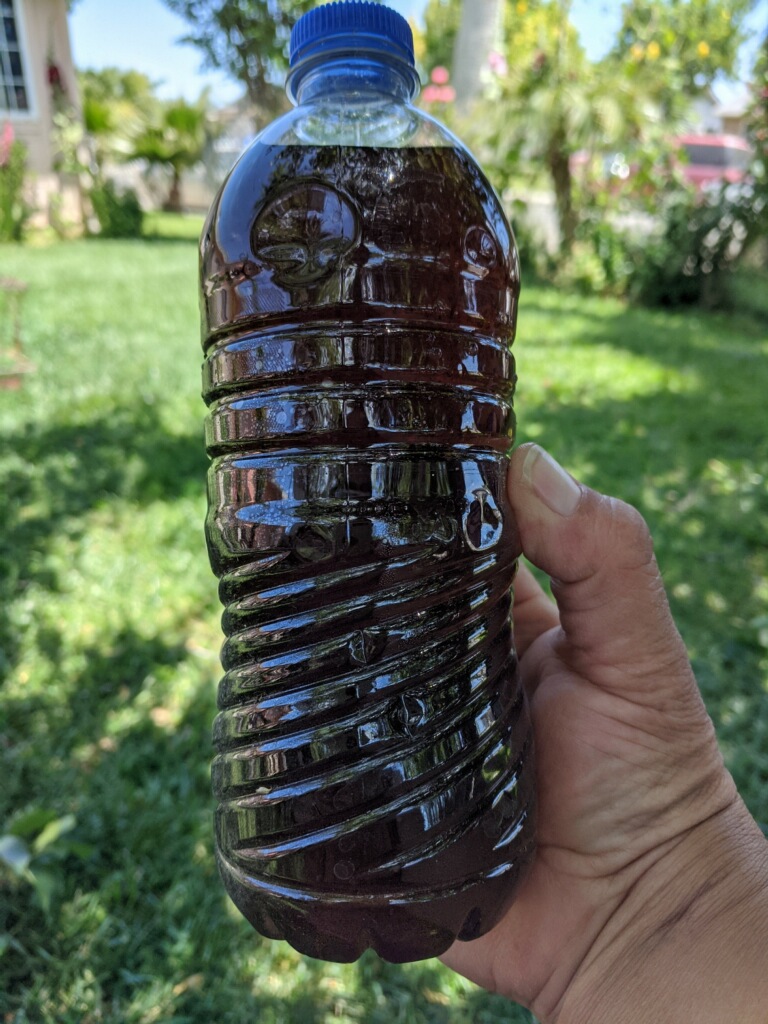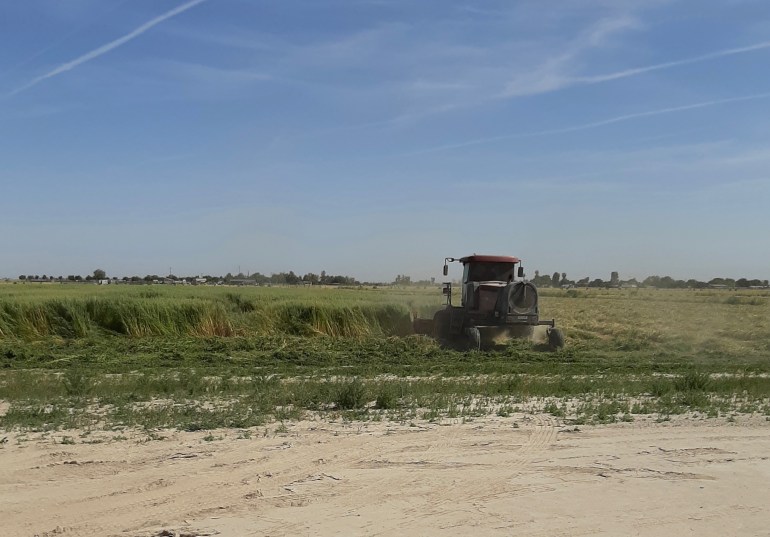Climate crisis: Will small California farms survive soaring heat?
The most profitable agricultural region in the US faces a significant rise in temperatures by the end of the century.

Los Angeles, California, US – Last summer was the hottest that Kayode Kadara can remember since the late 1970s, when he began visiting the San Joaquin Valley, the vast farming region between the Sierra Nevadas and the California coast.
The co-owner of TAC Farm, a small farm in Allensworth, said temperatures soared to at least 40 degrees Celsius for several days. He could work outside only for a short time before rushing back into his air-conditioned house.
Keep reading
list of 3 itemsIn Australia, farmers up in arms over renewable energy rollout
In Sierra Leone’s swamps, female farmers make profits and peace
The San Joaquin Valley – the most profitable agricultural region in the United States, with eight million acres of farmland and 200,000 workers who provide food to people in the US, Europe, Canada, China and other countries – faces a possible rise in annual average maximum temperatures of 2.7 degrees Celsius by mid-century, and up to 4.4 degrees Celsius by the end of the century, according to a new state-commissioned climate report released in January.
From 1950 to 2020, the valley’s temperature has increased by 0.6 degrees Celsius, the report noted. It found the climate crisis has already created water scarcity and over-reliance on groundwater, hitting small-scale farmers especially hard, including many Hmong, Latinx and African American farmers.
Droughts and earlier snowmelt runoff will increase water scarcity during the summer, especially in regions with irrigated agriculture, leading to economic losses and increased pressure on groundwater, a new report (PDF) released on Monday from the International Panel on Climate Change also predicted.
Kadara runs TAC Farm with his business partner and brother-in-law Dennis Hutson. The two dreamed of creating a sustainable farm as an economic engine in Allensworth, a once-thriving African American community founded in 1908 by an escaped slave and army colonel. Through regenerative practices, they transformed a depleted piece of sandy land into a nutrient-rich plot that produces wheat, oats, kale, alfalfa, watermelons and cantaloupes.

But the farm’s lifeblood is a 720-foot well that pumps water to the crops, and they must compete for water against nearby agricultural giants with the resources to drill down much deeper. Nine years ago, the water pump on their well stopped retrieving water, the pipe had to be adjusted to reach the water. In nearby Porterville, hundreds of wells have dried up in recent years.
“The studies to me are true. The forecast is basically what we’re seeing right now,” Kadara told Al Jazeera. “As it gets hotter, I don’t know what the heck we will do.”
Longer dry seasons
Hutson and Kadara are an odd pair: Hutson is an optimistic minister who preaches at two nearby churches, while Kadara is a pragmatist focused on innovation and science. In Allensworth, a low-income community of mostly farmworkers, Hutson envisioned the farm as a way to generate revenue so the county would “no longer view us as a community always with its hand out”. The farm is giving people “a sense of pride in their community”, he told Al Jazeera.
Kadara is proud of the farm’s sustainable practises; the wind used to blow chemical-filled dust from nearby farms onto the land, but they planted trees and shrubs as windbreaks. They use compost and grow cover crops to improve soil health, and they plan to install owl boxes to invite the natural predators to feast on gophers that chew on the water lines.
One of the main sources of water for the San Joaquin Valley is the snowpack in the Sierra Nevadas, which melts in spring and fills reservoirs. But as the region heats up, the amount of snow is decreasing, and it is melting earlier in the year. The rainy season is projected to grow shorter, with longer dry seasons in the summer, meaning surface water will be less available to farmers when they need it, forcing them to increasingly rely on groundwater.
Hutson and Kadara have water on their farm – for now. But they may have to drill deeper in future, at a cost of hundreds of thousands of dollars they do not have.
“We can talk about all the strategies to address climate change – stop using fossil fuels, switch to electricity and stuff like that – but what will it do now that the impacts are here?” Kadara said. “That’s the concern and the scary part for me. It’s here.”

Vulnerable communities
According to the climate report, more than 4.3 million people live in the San Joaquin Valley, and more than half are in disadvantaged communities.
The report’s lead authors, Jose Pablo Ortiz-Partida and Angel Santiago Fernandez-Bou, told Al Jazeera that small-scale farms are most at risk from climate change because their shallow wells are the first to dry up when groundwater is depleted. They have few resources to adapt and less political representation than large farms, and language barriers can also make things harder for Hmong and Latinx farmers.
Increasingly, farm workers are suffering from heat stroke, both in the field and at home, as many cannot afford air conditioning, Ortiz-Partida added.
“People think of climate change as something of the future, but we see its effects here in California, but especially the San Joaquin Valley, every day,” Fernandez-Bou said.
Hundreds of thousands of people in this region do not have reliable access to clean drinking water. As groundwater is depleted by climate change and over-extraction, the levels of sediments and pollutants in the well water increase. In the city of San Joaquin, in Fresno County, the tap water has run black due to high levels of manganese. Other communities have dangerous amounts of arsenic, pathogens such as E. coli, and cancer-causing chemicals such as chromium VI.
Climate change is exacerbating all these issues, while the lack of investment in critical infrastructure, including water and sewage systems, make these communities “some of the most vulnerable to climate change in the United States”, the report noted.

Regulating groundwater
According to Fernandez-Bou and Ortiz-Partida, small farmers who use regenerative practises are well-positioned to handle the climate crisis because their land can sequester carbon, and increase soil health and water retention. In addition, small farms tend to reinvest in their communities, leading to better socioeconomic outcomes on a broader scale. Kadara and Hutson also partnered with UC Berkeley to use an innovative method of removing arsenic from their well water.
“Regenerative agriculture is simply the practice of working in harmony with nature as opposed to working against it,” Hutson explained.
Kadara and Hutson know that valley residents will face pressure to move in the coming decades, but they personally have no plans to leave.
TAC Farm has received small government grants to upgrade its pump and irrigation pipe, and to build up nutrients in the soil. The farmers also hope a new law will increase water equity; California has long regulated surface water, but only recently passed the Sustainable Groundwater Management Act, which requires regions to develop plans to regulate groundwater along set timelines. But the new law is in its early stages, and some districts may not be able to fully implement sustainability plans by 2040, the report noted.
“Instead of complaining, I believe you can seize the opportunities and make good things happen,” Hutson said.
“You see, it doesn’t take much to get me to start preaching,” he joked. “I choose to think positively.”